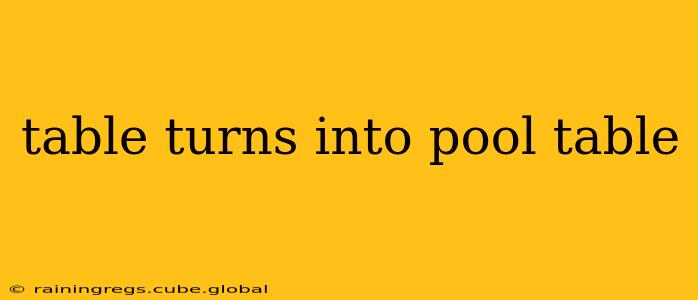Converting a standard table into a pool table might seem like a daunting task, but with careful planning and execution, it's achievable. This guide delves into the process, addressing common questions and concerns to help you transform your ordinary table into a stylish and functional pool table.
What Kind of Table Can Be Converted?
This is a crucial first step. Not all tables are suitable for conversion. Ideally, you need a sturdy, rectangular table with a flat, level surface. The dimensions should be carefully considered to ensure they accommodate a standard pool table's size and playing area. Solid wood tables are generally preferred for their stability and ability to withstand the added weight and stress of a pool table conversion. Avoid tables made of particleboard or other less robust materials.
How Much Does It Cost to Convert a Table into a Pool Table?
The cost varies significantly depending on several factors: the quality of the original table, the materials used for the conversion (slate, felt, rails, etc.), whether you do the work yourself or hire a professional, and the desired level of finish. A DIY conversion will generally be more affordable, but professional installation ensures a superior, long-lasting result. Budget for the cost of materials, tools (if DIY), and potential labor costs.
Can You Convert a Dining Table into a Pool Table?
Technically, yes, provided the dining table meets the criteria mentioned earlier (sturdy construction, appropriate dimensions, flat surface). However, converting a cherished dining table might not be the best approach. Consider the potential damage to the original table and whether the aesthetic result aligns with your expectations. A less valuable, more readily replaceable table is a better candidate for this type of project.
What Materials Do I Need to Convert a Table into a Pool Table?
The essential materials include:
- Slate: Provides a perfectly level playing surface, critical for accurate gameplay. The thickness of the slate influences the table's quality and cost.
- Felt: Covers the slate and provides a smooth surface for the balls to roll. Different qualities of felt offer varying levels of durability and playing characteristics.
- Pool Table Rails/Cushions: Provide bounce and guide the balls during play. These need to be carefully fitted to the table's dimensions.
- Table Legs (potentially): Depending on the stability of your existing table's legs, you may need to reinforce or replace them.
- Fasteners, screws, etc.: Secure all components for a stable and durable build.
What Tools Are Needed for the Conversion?
The tools required depend on your DIY skills and the complexity of the conversion. However, you'll likely need some or all of the following:
- Measuring tape: Crucial for accurate measurements and planning.
- Level: Ensures a perfectly flat playing surface.
- Drill: For securing components.
- Screwdrivers: To fasten various parts.
- Saw (possibly): May be necessary to modify existing table components.
- Sandpaper: For smoothing surfaces.
Is Converting a Table to a Pool Table Worth It?
The "worth it" aspect depends entirely on your priorities, budget, and DIY skills. If you're handy and want a unique, personalized pool table, it can be a rewarding project. However, purchasing a ready-made pool table might be more cost-effective and less time-consuming in the long run. Weigh the pros and cons carefully before embarking on this project.
This guide provides a starting point for transforming your table into a pool table. Remember to prioritize safety, plan thoroughly, and carefully consider the costs and effort involved before beginning. Good luck with your project!
